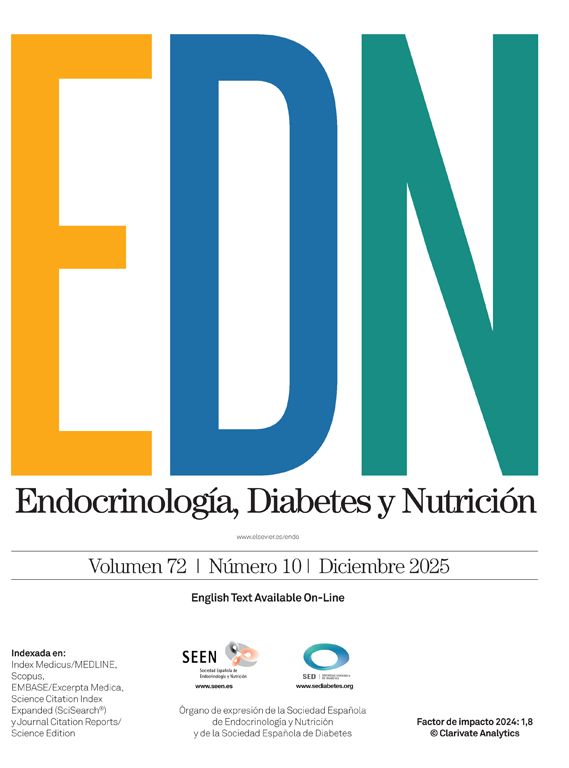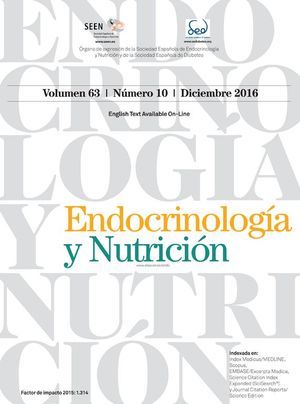La revista consta de las siguientes secciones:
Originales. Trabajos originales de investigación clínica, traslacional o experimental que contemplen cualquier aspecto relacionado con la endocrinología, nutrición, diabetes o metabolismo. Los diseños recomendados son de tipo analítico en forma de estudios observacionales (transversales, estudios de casos y controles, estudios de cohortes) que sigan la metodología STROBE y ensayos aleatorizados y controlados que sigan la metodología CONSORT y estén registrados en una base de datos pública.
El artículo deberá tener un máximo de 4.000 palabras, sin incluir la bibliografía, el resumen y las leyendas de las figuras. Se estructurará en los siguientes apartados: Introducción, Material y métodos, Resultados y Discusión. Sólo se admiten subapartados en los apartados de Material y métodos y de Resultados. El resumen (en español y en inglés) puede tener un máximo de 250 palabras y debe estar estructurado. La bibliografía debe ceñirse a un máximo de 30 referencias. Se aceptarán un máximo de 6 tablas y/o figuras en total. Se incluirá un apartado de hallazgos principales, junto al resumen, de no más de 80 palabras, repartidas en 4 o 5 frases. Así mismo, se anima a los autores a aportar un resumen gráfico del articulo.
Revisiones sistemáticas y metaanálisis. Se recomiendan las revisiones sistemáticas utilizando los criterios PRISMA o MOOSE. Se recomienda que el protocolo de revisión esté registrado en una base de datos pública y que se incluya el número de referencia en la publicación.
El artículo deberá tener una extensión máxima de 5.000 palabras, sin incluir la bibliografía, el resumen y las leyendas de las figuras. Deberá estar estructurado en los apartados siguientes: Introducción, Material y Métodos, Resultados y Discusión. El resumen (en español y en inglés) puede tener un máximo de 250 palabras y debe estar estructurado. No hay límite de referencias bibliográficas, siempre que estén justificadas. Se aceptarán un máximo de 6 tablas y/o figuras en total. Si es necesario, pueden complementarse con tablas/figuras suplementarias.
Otro tipo de revisiones: a propósito de un caso. Se contempla la actualización de un tema a propósito de un caso clínico. Este tipo de manuscritos pueden ser por encargo o remitirse por iniciativa de los autores. Tendrán una extensión máxima de 2.500 palabras, y un resumen sin estructurar de 150 palabras, las palabras clave correspondientes y hasta 50 referencias bibliográficas. Se admitirán hasta 3 figuras y/o tablas. Se estructurará en: descripción del caso, manejo (y evidencias que lo justifiquen), áreas de incertidumbre, guías y conclusión y recomendaciones.
Cartas Científicas. Se podrán incluir las descripciones de uno o más casos clínicos de excepcional observación que supongan una aportación importante al conocimiento de la fisiopatología o de otros aspectos de las enfermedades endocrinas. También podrán versar sobre experiencias o resultados de investigación que por sus características no tengan la suficiente entidad para ser publicados como artículo original. La extensión máxima del texto será de 1.000 palabras, y no se estructurará en apartados. Asimismo, tampoco se deberán acompañar de resumen. Se aceptará 1 figura o 1 tabla. La bibliografía no debe superar las 10 referencias. El número máximo de autores será de 5.
Cartas al Editor. Las Cartas al Editor pueden hacer referencia a trabajos publicados en la revista, o bien aportar opiniones en torno a un tema de actualidad. La extensión máxima será de 1.000 palabras, y se admitirán 1 figura o 1 tabla, y 10 referencias bibliográficas como máximo. El número máximo de autores será de 4.
Revisiones narrativas/artículos especiales. Se harán por encargo del Comité Editorial, o si éste acepta la propuesta de autores interesados. El artículo deberá tener una extensión máxima de 5.000 palabras, sin incluir la bibliografía, el resumen y las leyendas de las figuras. Tendrán un resumen sin estructurar de 150 palabras. No hay límite de referencias bibliográficas, siempre que estén justificadas. Se aceptarán un máximo de 6 tablas y/o figuras en total. Si es necesario, pueden complementarse con tablas/figuras suplementarias.
Otras secciones. La revista incluye editoriales, que se realizan por encargo del Comité Editorial. Los autores que espontáneamente deseen colaborar en alguna de estas secciones deberán consultar previamente al Comité Editorial de la revista. Endocrinología, Diabetes y Nutrición publicará, asimismo, guías clínicas y documentos de consenso promovidos por la SED y la SEEN directamente o a través de sus grupos de trabajo, siempre y cuando este tipo de documentos se hayan realizado siguiendo la normativa conjunta establecida por la SED-SEEN (más información en http://www.seen.es/) y sigan la metodología AGREE para guías de práctica clínica (https://www.agreetrust.org).
Las guías elaboradas conjuntamente con otras sociedades científicas, podrán publicarse en Endocrinología, Diabetes y Nutrición, y en paralelo en las publicaciones de las otras sociedades científicas siempre y cuando se haya seguido la normativa establecida por la SED-SEEN y sigan la metodología AGREE. En este caso el autor de correspondencia adjuntará una carta de presentación donde se indicará las Sociedades que avalan el Documento (adjuntando el aval de cada Sociedad), así como las revistas a las que se enviará el consenso.
La revista publicará la guía o el documento de consenso aceptado por el Comité Editorial como un Resumen Ejecutivo (“Executive summary”), cuya extensión máxima será de 3.000 palabras, además de un resumen no estructurado que tendrá un máximo de 150 palabras. Se acompañará de las tablas y figuras que se consideren convenientes para ayudar a interpretar la información de una forma clara y concisa, y se enviará en inglés. El título se iniciará con la siguiente frase: “Resumen ejecutivo (Executive summary) de la guía/consenso…”. El documento de consenso completo se publicará online como material adicional al Resumen Ejecutivo y/o como un suplemento de la revista. El objetivo de la publicación del Resumen Ejecutivo es ofrecer a los lectores una síntesis del documento de consenso, pero con el suficiente detalle y claridad para entender el alcance y los puntos más relevantes del documento completo. Se publicarán un máximo de 6 resúmenes ejecutivos anuales en el primer número de cada año, dando prioridad a aquellos realizados de forma conjunta entre las dos sociedades. Los artículos deben ser enviados a la(s) junta(s) de la(s) sociedad(es) correspondiente(s) antes del 30 de junio para su evaluación y selección.
La definición de autoría se guiará por las recomendaciones del International Committee of Medical Journals Editors (ICMJE, https://www.icmje.org/recommendations/browse/roles-and-responsibilities/defining-the-role-of-authors-and-contributors.html).





